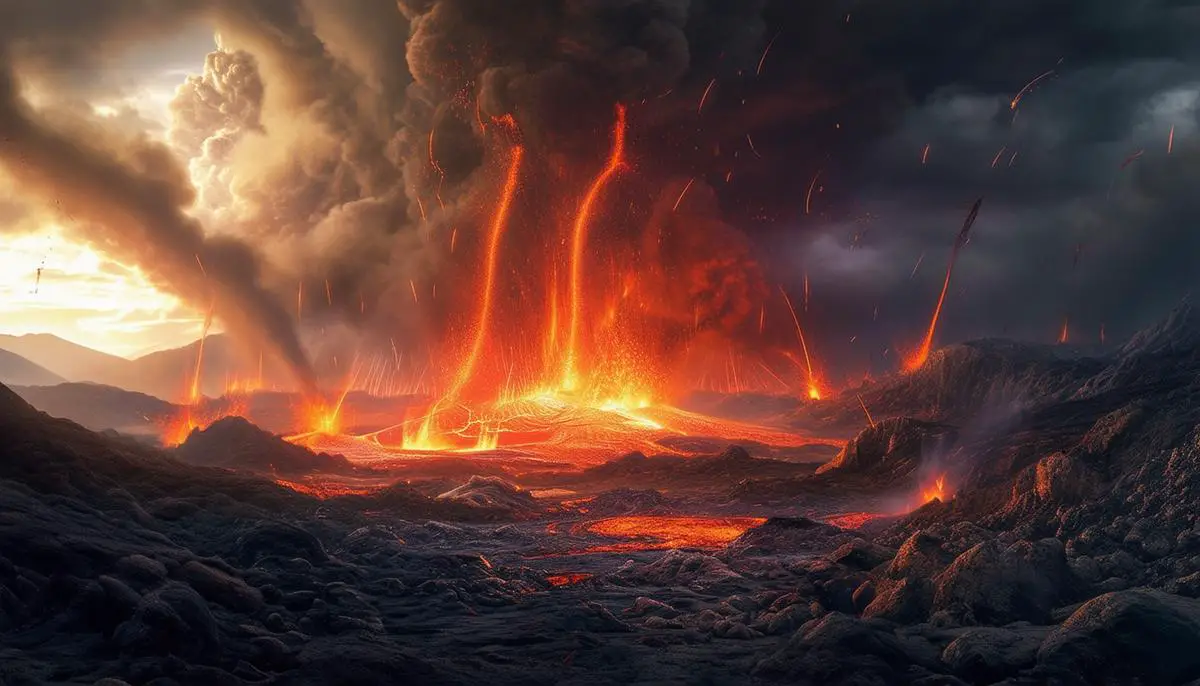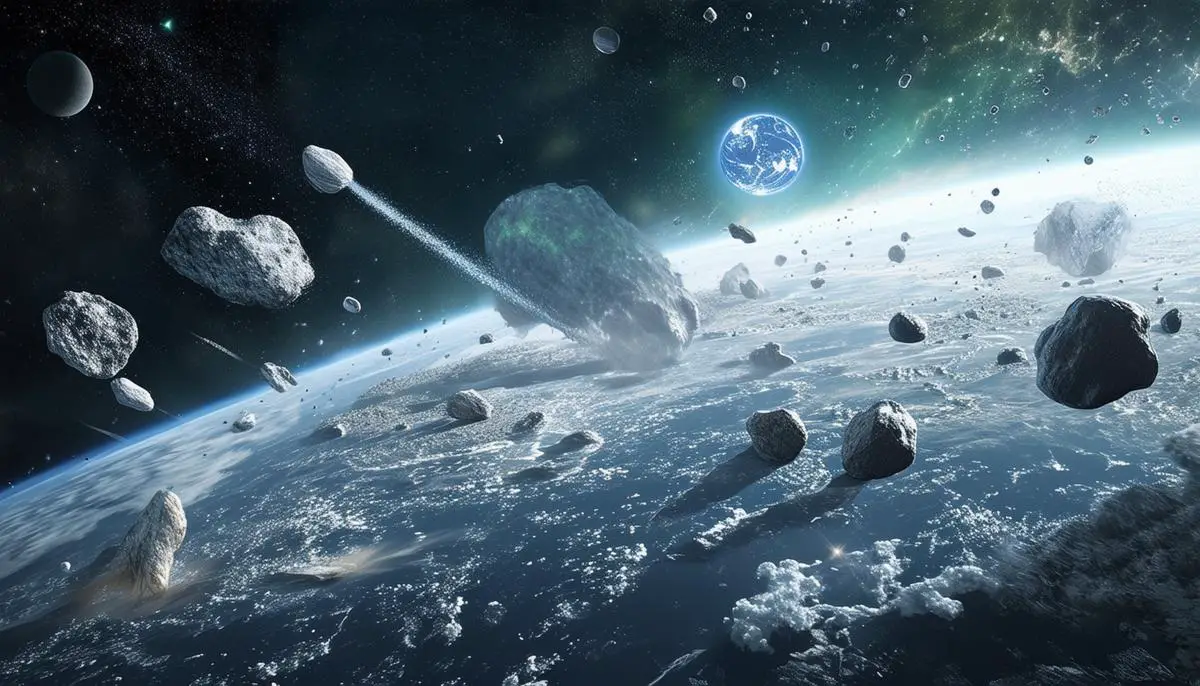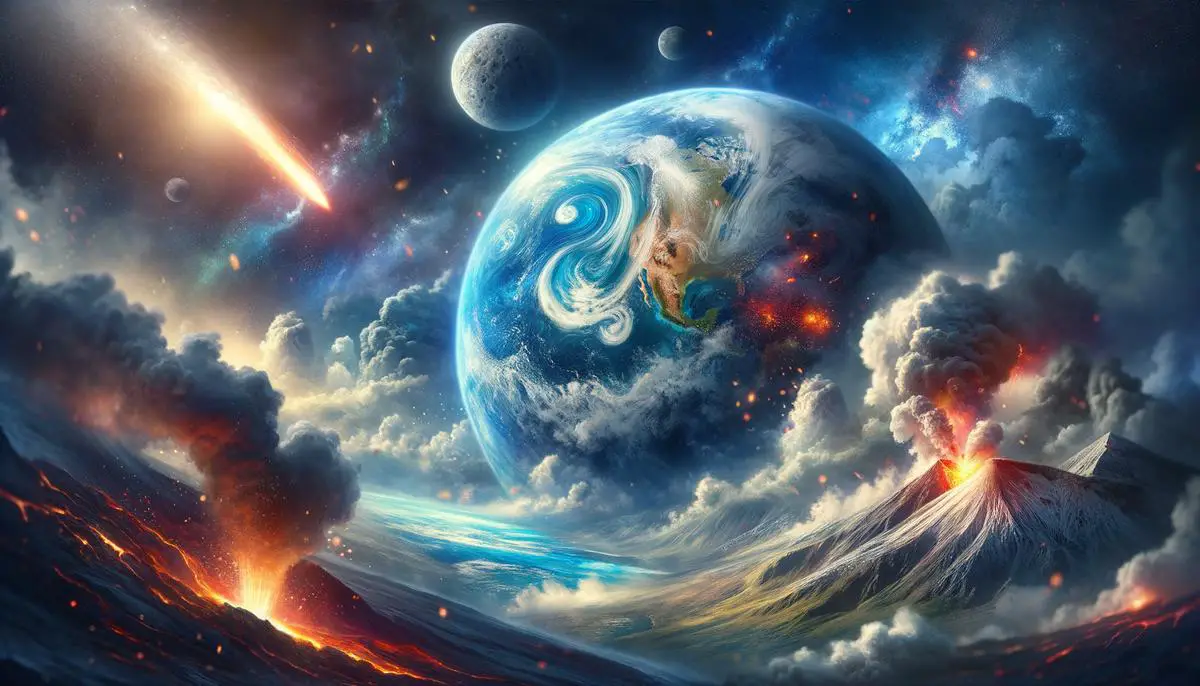The formation of early Earth and the origins of its water reveal intricate processes that shaped our planet. From volcanic outgassing to celestial impacts, each event contributed to the development of Earth's oceans and atmosphere, offering insights into the dynamic interactions between geological and biological systems that have sustained life for billions of years.
Formation of Early Earth and Initial Conditions
The early Earth was a chaotic, molten landscape formed by the accretion of planetesimals. During this fiery origin, temperatures soared, making liquid water an impossibility. As Earth coalesced and began to mature, intense volcanic activity played a pivotal role in shaping the early atmosphere.
Volcanoes released gases, including water vapor, carbon dioxide, and sulfur dioxide. This outgassing process involved the release of gases initially dissolved in magma. As the magmas ascended and pressure dropped, these gases were released into the atmosphere. The heavier gases didn't dissipate into space like their lighter counterparts, hydrogen and helium.
Earth's early atmosphere lacked free oxygen, as evidenced by the absence of oxidized iron minerals in sedimentary beds older than two billion years. Chemical reactions swiftly consumed any O2 generated by ultraviolet rays splitting water molecules. The emergence of photosynthetic organisms introduced significant levels of oxygen into the atmosphere, utilizing abundant CO2 and releasing O2 as a by-product.
As volcanic activity and outgassing continued, the planet began to cool. Water vapor in the atmosphere condensed, falling as rain and leading to the first permanent water bodies on Earth. By about 4 billion years ago, this process resulted in the formation of oceans. The cooling and condensation of water vapor set the stage for the hydrological cycle, a continuous movement of water between reservoirs.
The Hydrological Cycle:
- Evaporation of water from oceans, lakes, streams, and land surfaces
- Transport of water vapor through the atmosphere by winds
- Formation of clouds
- Precipitation as rain or snow
- Water flow through rivers and streams or infiltration into groundwater
Earth's water is predominantly stored in the oceans, holding 97% of the planet's water. The remaining 3% is fresh water, primarily trapped in ice and groundwater, with a small amount in lakes, streams, vegetation, and the atmosphere. To visualize this scale, imagine a 1-liter jug filled with 970 milliliters of salty water, a single ice cube representing glaciers, a few teaspoons of groundwater, and mere drops representing all visible water bodies.
The atmosphere contains approximately 13,000 km³ of water continuously cycling as vapor and clouds. Daily, 1,580 km³ of water is evaporated and precipitated. Runoff from land contributes to this flow, with 117 km³ of stream flow and 6 km³ of groundwater flow moving back to the ocean each day. This dynamic equilibrium illustrates that, despite constant flux, the composition of Earth's water in different forms remains relatively stable.

Theories on the Origin of Water
Several theories explain the origin of water on Earth, each contributing to our understanding of this crucial element's presence on our planet.
- Volcanic outgassing: Water was present in minerals and compounds deep within Earth's mantle. During volcanic eruptions, these substances were released as water vapor among other gases. As Earth cooled, the vapor condensed into liquid, gradually filling oceanic basins.
- Accretion theory: Water was incorporated during Earth's formation. Planetesimals, small celestial bodies that collided to form Earth, carried water in the form of hydrated minerals. This concept suggests that water was integrated from the beginning of Earth's formation.
- Bombardment theory: Comets and asteroids provided a significant amount of Earth's water. During the late heavy bombardment period, around 4 billion years ago, many water-rich celestial objects collided with the young Earth, potentially releasing vast quantities of water upon impact.
It's likely that a combination of these theories presents a more comprehensive explanation. The synergy of endogenous processes (volcanic activity and water-imbued minerals) and exogenous contributions (water-rich comet collisions) underscores the intricate nature of our planet's history.
Ongoing research, including sample return missions from asteroids like OSIRIS-REx and Japan's Hayabusa2, brings scientists closer to uncovering the precise balance of these contributing factors. Understanding the origin of Earth's oceans not only satisfies our curiosity about our own planet but also sharpens our perspective in the search for life elsewhere in the cosmos.

Formation of the Oceans
As Earth cooled, water vapor in the atmosphere began to condense, accumulating in depressions and low-lying areas. Around 4 billion years ago, these accumulations marked the formation of Earth's first oceans, rivers, and lakes, setting the stage for a series of geological and biological events.
This period illustrated a grand interaction between the atmosphere, land, and liquid water. As primordial rains persisted, vast saline bodies filled the basins carved on the planet's surface due to past volcanic and tectonic activities. This marked the birth of the hydrological cycle, a system that perpetually rejuvenates and recycles water across Earth's surface.
"The hydrological cycle involves the constant movement of water between various reservoirs—oceans, atmosphere, land, and subterranean areas. Driven by solar energy, water evaporates from various sources, condenses in the atmosphere to form clouds, and returns to Earth as precipitation."
Groundwater, a vital component of the hydrological cycle, slowly weaves through rock layers, sometimes emerging back into surface water bodies or directly seeping into the oceans. This underground journey can span years, decades, or even millennia, making groundwater reserves both a current resource and a historical archive of Earth's climatic past.
Despite turbulent beginnings, water distribution on Earth has reached a relatively stable equilibrium. Oceans dominate, holding 97% of Earth's water in a saline state. Freshwater constitutes just 3%, with two-thirds locked in glaciers and polar ice caps, and the rest largely residing as groundwater. Lakes, rivers, and moisture within vegetation and the atmosphere constitute an even smaller fraction.
| Water Source | Percentage |
|---|---|
| Oceans (Saline) | 97% |
| Freshwater | 3% |
| – Glaciers and Polar Ice Caps | 2% |
| – Groundwater | 0.9% |
| – Other (Lakes, Rivers, Atmosphere) | 0.1% |
The atmosphere contains approximately 13,000 cubic kilometers of water at any given moment, continuously exchanged through evaporation and precipitation at a rate of about 1,580 cubic kilometers per day. This delicate equilibrium ensures that water is perpetually cycled and available, albeit unevenly, across the globe.
Understanding Earth's water cycle offers profound insights into the planet's capability to support life. It underscores the resilience of the mechanisms that maintain balance despite continuous environmental changes. As we explore potential habitats in distant worlds, this knowledge enhances our ability to discern the intricate conditions that turned our blue planet into a cradle of life.
Salinity of the Oceans
Ocean salinity stems from several interlinked processes: outgassing, weathering of rocks, and runoff. These processes have contributed to the ocean's salt content since Earth's early days.
Volcanic outgassing was a significant initial contributor, releasing water vapor and elements like chlorine and sulfur into the atmosphere. These elements eventually formed salts in water bodies.
The weathering of continental rocks and minerals plays a crucial role in maintaining salinity. Slightly acidic rainwater erodes rocks, breaking down minerals into ions. Rivers and streams transport these dissolved ions, such as sodium and chloride, to the oceans.
Runoff carries a mixture of dissolved substances from the weathering process to the seas, constantly replenishing their salinity. As water traverses varied terrains, it gathers minerals before merging with ocean waters.
Despite this constant influx, ocean salinity remains remarkably stable due to the concept of residence time – the average duration an ion stays in the ocean before removal. Residence time varies among ions, influenced by their chemical reactivity and biological usefulness.
Balance of Ocean Salinity
- Input processes: weathering, runoff, volcanic activity
- Removal processes:
- Biological uptake
- Sedimentary deposit formation
- Sea spray
- Interactions with hydrothermal vents
This balance ensures the overall chemical composition of seawater remains largely unaltered over time, despite local variations due to climate change or geological activity. The result is the vast, consistent salinity of the oceans we observe today, which plays an essential role in Earth's climate system and oceanic circulation patterns.
Extraterrestrial Contributions
Comets, asteroids, and interstellar objects have played crucial roles in delivering water to Earth's oceans, particularly during the planet's early years. The late heavy bombardment period, when the inner solar system experienced numerous impacts, was likely a key epoch for such contributions.
Comets, composed largely of ice and dust, released their watery cargo upon impact with the young Earth. However, recent research suggests they were not the sole contributors. The European Space Agency's Rosetta mission found that water on comet 67P/Churyumov-Gerasimenko had a higher deuterium-to-hydrogen ratio compared to Earth's ocean water1.
Asteroids, particularly carbonaceous chondrites, have been identified as potential water bearers. Studies of meteorites from these asteroids reveal water content and isotopic similarities to Earth's oceans2.
Interstellar objects like 'Oumuamua and 2I/Borisov introduce the possibility of water sources from beyond our solar system. Dark comets, which lack visible tails but demonstrate comet-like accelerations, may have also contributed to Earth's water reservoirs.
"Understanding how these celestial bodies delivered water to Earth provides insight into planetary formation processes and the potential for life elsewhere."
Sample return missions like NASA's OSIRIS-REx and Japan's Hayabusa2 are poised to offer unprecedented insights into extraterrestrial water delivery. These missions will allow scientists to analyze water content and isotopic ratios with high precision, potentially revolutionizing our understanding of Earth's water sources.
This ongoing research reinforces Earth's story as part of a grand cosmic interplay, showcasing our planet's watery legacy as a testament to both its internal dynamics and the contributions of distant celestial travelers.

The story of Earth's water is a testament to the planet's resilience and adaptability. By examining both terrestrial and extraterrestrial contributions, we gain a deeper appreciation for the complex mechanisms that have made Earth a cradle of life. This knowledge enriches our understanding of our own world and guides our search for life beyond our solar system.
![]()
